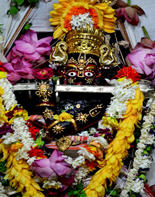Sri Kaisranandadeva Gosvami, a disciple of Rasikananda, wrote a book in Oriya, the language of Orissa, telling how the Gopinatha Deity came to Remuna.

The book relates that in Treta-yuga, more than a million years ago, the Supreme Lord Ramacandra and His wife, Sita Devi, lived for some time at Chitrakut, in north central India. Once during the rainy season a strong storm forced Rama and Sita to take shelter in the asrama of some sages. On seeing many cows in the asrama and hearing their mooing, Lord Ramacandra told Sita, “Seeing all these cows, I’m reminded of My pastimes in Dvapara-yuga.” Lord Rama was referring to His later appearance as Lord Krsna.
Sita Devi said, “What do You mean? Please tell me about those pastimes.”
Lord Rama replied, “Just wait for a week. With an arrow I’ll carve some pictures of those pastimes in a black rock, and you will be able to see them.
“But after four days Sita said, “I can’t wait any longer. Please show me what You’ve done.”
To please her, Lord Ramacandra then showed her the carvings. He had completed a Deity of Gopala Krsna (His back still attached to the stone) and, on the stone itself, drawings of Krsna’s eight principal gopis(cowherd girlfriends) and four maid-servants to the gopis. Also depicted were twelve cows, Lord Balarama wrestling Mustika, Lord Krsna wrestling Canura, and a few other scenes.
Pleased to see all this, Sita began worshiping the Gopala Deity at Chitrakut. After a few days Rama and Sita left, so Lord Brahma, the creator of the universe, came and took over the worship of the Deity (a service he was to perform through the rest of Treta-yuga, through Dvapara-yuga, and for several centuries of Kali-yuga).
When Lord Ramacandra returned to India from Lanka after killing the demon Ravana, He stopped for four days at the place now known as Remuna. Sita Devi wanted to bathe there in the Ganges, so Lord Rama shot seven arrows into the ground and brought forth the Ganges. Today that place is called Saptashara, “seven arrows.” A deity of Lord Siva named Gargasvara was later installed there. Near by stands a deity of Durga Devi known as Ramacandi. Because Lord Ramacandra felt pleasure (ramana) at that place, it came to be known as Remuna.
In the thirteenth century King Langula Narasimhadeva from Orissa was traveling to holy places with his queen and many great sages. At Chitrakut they saw the Deity of Gopala. Not knowing that Lord Brahma was coming there daily, the king was astonished that no one was worshiping such a beautiful Deity.
That night the Deity appeared to the king in a dream and asked to be taken to a more populated place. The king decided to take Gopala to Jagannatha Puri.
The king selected some qualified brahmanas to worship the Deity and started for Puri. But when they reached Remuna, a beautiful cowherd village, Gopala again appeared to the king in a dream and asked to be installed and worshiped there. The village people, delighted, gave the Deity large quantities of milk and milk products every day. The queen noticed that the Deity was accompanied by carvings of the eight principal gopis, so she named Him Gopinatha, “Lord of the gopis.”